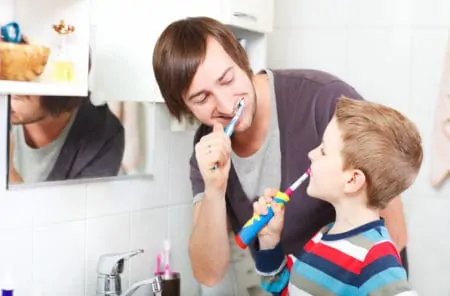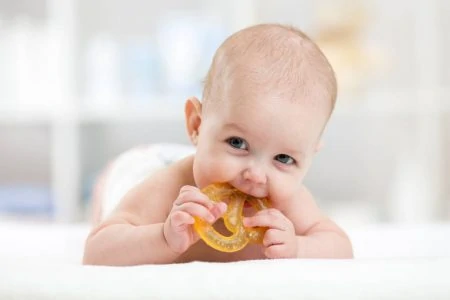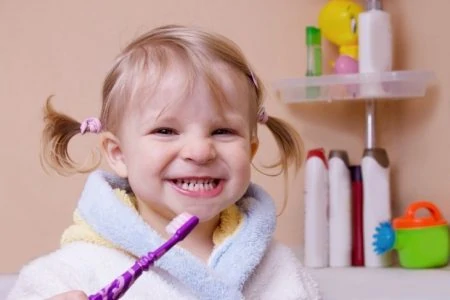Is your baby turning into a little drool fountain? If you’ve noticed a red, bumpy patch on their chin or cheeks, you aren’t alone. That irritation is likely a teething rash.
It looks uncomfortable, and let’s be honest, it doesn’t make for the best baby photos. But don’t worry. This is a very common side effect of teething.
We’ve dealt with our fair share of soaked bibs and sensitive chins. We consulted medical experts to break down exactly why this happens, how to treat it, and, most importantly, how to keep that sweet baby skin smooth and pain-free.
Key Takeaways
- What is it? Teething rash (or drool rash) appears as red, chapped, or bumpy skin around the mouth, chin, neck, and chest.
- The cause: Saliva contains digestive enzymes. When excessive drool sits on the skin, these enzymes break down the skin barrier, causing irritation.
- Prevention is key: Keep skin dry by patting (not rubbing) with a soft cloth and applying a barrier ointment like petroleum jelly before the drool starts flowin.
- Treatment: Keep the area clean, change wet clothes frequently, and use cold teethers to soothe the gums and reduce the urge to gnaw.
What Is a Teething Rash?
A teething rash, frequently called a drool rash, is a form of contact dermatitis. It typically shows up as red, splotchy patches or small, raised bumps. The skin usually looks chapped and dry to the touch.
Because saliva is often involved, you might also notice a slightly sour smell coming from the rash area, especially in the folds of the neck.
It is important to look for other teething symptoms alongside the developing rash. If you can pinpoint the source, you can treat it faster.
Here are a few common signs your baby is teething:
- Visible eruption: You can see a tooth popping through the gum line.
- Sensitivity: Your baby has swollen, tender gums.
- Ear tugging: Gum pain travels, often causing an odd sensation in the ears.
- Gnawing: Excessive biting or sucking on fingers, toys, or crib rails.
While the rash loves the lips, chin, and cheeks, don’t be surprised if it migrates. Gravity pulls drool down, so you might find red patches on your baby’s neck, chest, and even their hands if they are constant thumb-suckers.
What Causes Teething Rash?
The main culprit behind those angry red bumps is actually a good thing in disguise: saliva.
Saliva contains digestive enzymes. These enzymes are designed to break down food so our bodies can digest it. As your baby grows and their salivary glands develop, they produce more of this liquid gold.
Since babies haven’t mastered the art of swallowing all that extra fluid yet, it flows out as drool.
When teething kicks in, those glands go into overdrive. The physical act of teeth erupting stimulates the reflex to salivate (1).
When that enzyme-rich saliva sits on your baby’s delicate skin, it starts to digest the skin cells just like it would food. The result? Irritation, redness, and a rash.
Teething Rash vs. Eczema vs. HFM
Sometimes it is hard to tell if it’s just drool or something else. Here is a quick cheat sheet to help you distinguish teething rash from other common skin issues.
- Teething Rash: Concentrated around the mouth, chin, neck, and chest. It usually doesn’t itch, but it burns or stings. It comes and goes with drool flow.
- Eczema (Atopic Dermatitis): This can appear anywhere, but in babies, it often shows up on cheeks, scalp, and joints (elbows/knees). It is intensely itchy and dry. If there is a family history of eczema or allergies, this is more likely.
- Hand, Foot, and Mouth (HFM): This is a viral infection. You will see blister-like sores inside the mouth, on the palms of hands, and soles of feet. It is often accompanied by a fever.
Why Is the Rash Spreading?
If teething rash is caused by drool on the face, why is it on your baby’s belly or hands? There are two main reasons the rash travels:
- The gravity factor: Drool doesn’t stay put. It drips down the chin, settles into the deep folds of the neck (a breeding ground for moisture), and soaks into the top of the shirt, irritating the chest.
- The transfer factor: Babies soothe themselves by chewing on their hands and feet. This transfers that enzyme-heavy saliva to their extremities. Plus, when they rub their itchy face, they spread the saliva around.
If you see a rash spreading but your baby is perfectly dry and showing no signs of teething, consult your pediatrician. It might be an allergic reaction or a viral rash.
Sometimes, a red, bumpy rash can develop in the folds of your baby’s neck. Yeast likes to grow in those wet, warm, and irritated areas. You will know because it will become redder and worsen, specifically in the neck crease. Contact your baby’s doctor if you see this or are concerned about a possible yeast infection.
Editor's Note:
Dr. Gina Jansheski, MD, FAAPHow Can I Prevent Teething Rash?
Want to stop the rash before it starts? Prevention is all about moisture management.
Here are a few helpful tips to keep your baby’s skin barrier intact:
1. Keep the Drool at Bay
The golden rule: keep the skin dry. Keep a soft burp cloth or muslin square handy and dab the drool away frequently.
Crucial tip: Do not wipe or rub. Rubbing acts like sandpaper on wet skin and will cause immediate irritation. gentle dabs only.
If your baby is a heavy drooler, use a bib to protect the neck and chest. Look for absorbent bibs with a fleece or waterproof backing. If the bib gets soaked, change it immediately so the wet fabric doesn’t sit against the chest.
2. Create a Barrier
Think of this as waterproofing your baby. Before the drool starts flowing (or right after you pat them dry), apply a barrier ointment.
Petroleum jelly (Vaseline), healing ointments (like Aquaphor), or a lanolin cream work wonders. They sit on top of the skin, preventing the saliva enzymes from making direct contact with the epidermis.
Reapply this thin layer frequently, especially before naps and bedtime.
3. Limit the Pacifier
We know, the pacifier is a lifesaver. But it also traps saliva against the skin around the mouth. The plastic shield creates a little moisture chamber that guarantees a rash.
If you can, limit pacifier use during the day. If they need it, try to wipe the area around their mouth often or use a pacifier with large air holes in the shield to let the skin breathe.
4. Watch the Laundry
If drool soaks into clothes, the wet fabric rubs against the skin, causing friction burns on the tummy and chest. Change your baby’s top as soon as it feels damp.
Also, check your detergent. A gentle laundry detergent is essential. Strong fragrances can irritate skin that is already compromised by teething enzymes.
How To Treat Teething Rash
If the rash has already arrived, don’t panic. It looks worse than it is. With consistent care, you can clear it up quickly.
Follow these steps to help your baby find relief.
1. Pat, Don’t Rub
We mentioned this in prevention, but it is doubly true for treatment. The skin is already inflamed. Any friction will hurt. Use a super soft cloth and gently blot the moisture away.
If you are home, let your baby go shirtless for a while. Air drying is one of the best ways to heal a moisture rash.
It is a good idea to protect any raw areas by using a “barrier cream” such as petroleum jelly to repel moisture. Just make sure to dry the area gently before applying a thin layer to seal the moisture out.
Editor's Note:
Dr. Gina Jansheski, MD, FAAP2. Soothe and Seal
Clean the area with warm water (skip the soap if it’s irritating) and pat dry. Then, apply a healing barrier.
Avoid standard lotions, which can sometimes sting broken skin. Stick to thick ointments like petroleum jelly or a balm containing coconut oil. These seal the skin off from further damage while it heals from the inside out.
3. Cover the Hands
If your baby keeps scratching the rash or sucking on their hands (re-wetting the area), try using scratch mittens during sleep.
During the day, keep their nails trimmed short to prevent them from breaking the skin if they do scratch.
4. Cool It Down
Treat the cause of the drool: the gum pain. Give your baby something cold to chew on. The cold constricts blood vessels and numbs the pain, which can temporarily reduce the heavy saliva flow.
Try chilled teething rings or a damp, frozen washcloth. Just supervise them closely.
5. Massage the Gums
A clean finger massage on the gums can work wonders. It relieves pressure and helps distract the baby from the itchiness of the rash.
Watch the video below to master the baby gum massage technique.
How Long Will a Teething Rash Last?
With diligent “patting and greasing” (keeping it dry and applying ointment), a teething rash usually clears up in a few days.
However, as long as the tooth is pushing through and the drool is flowing, the rash can flare up again. It is often a game of management until the tooth finally pops.
If the rash doesn’t improve after a week of home treatment, or if it seems to be causing your baby pain, give the doctor a call.
Teething Rash Treatment Products
You don’t need a medicine cabinet full of prescriptions, but having the right tools makes a huge difference. Here are the essentials that help parents survive the drool years.
- Absorbent Bibs: Look for “bandana bibs” with a fleece backing. They sit higher on the neck to catch dribbles before they hit the skin.
- Barrier Ointment: Petroleum jelly or Aquaphor are gold standards. They are cheap, effective, and safe if a tiny bit gets in the mouth.
- Food Feeders: Silicone feeders are great for putting frozen breastmilk or fruit pops in. They soothe the gums while keeping sticky messes contained.
- Scratch Mittens: Mittens prevent your baby from clawing at an itchy face while they sleep.
When To Call The Doctor
Most teething rashes are harmless, but broken skin can invite bacteria.
Call your pediatrician if:
- The rash becomes bright red, swollen, or warm to the touch.
- You see pus, yellow crusting, or weeping fluid (signs of impetigo).
- Your baby develops a fever.
- The rash spreads rapidly to other parts of the body.
- You suspect it might be thrush (a yeast infection), which looks like white patches in the mouth and a red rash around the lips.








